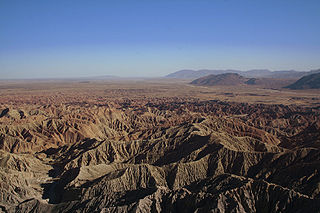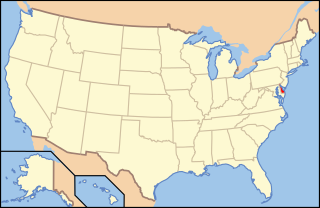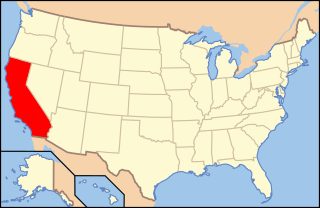
The Devonian is a geologic period and system of the Paleozoic, spanning 60.3 million years from the end of the Silurian, 419.2 million years ago (Mya), to the beginning of the Carboniferous, 358.9 Mya. It is named after Devon, England, where rocks from this period were first studied.

An extinction event is a widespread and rapid decrease in the biodiversity on Earth. Such an event is identified by a sharp change in the diversity and abundance of multicellular organisms. It occurs when the rate of extinction increases with respect to the rate of speciation. The number of major mass extinctions in the last 440 million years are estimated from as few as five to more than twenty. These differences stem from disagreement as to what constitutes an extinction event as "major", and the data chosen to measure past diversity.

A fossil is any preserved remains, impression, or trace of any once-living thing from a past geological age. Examples include bones, shells, exoskeletons, stone imprints of animals or microbes, objects preserved in amber, hair, petrified wood, oil, coal, and DNA remnants. The totality of fossils is known as the fossil record.

Paleontology, also spelled palaeontology or palæontology, is the scientific study of life that existed prior to, and sometimes including, the start of the Holocene epoch. It includes the study of fossils to classify organisms and study their interactions with each other and their environments. Paleontological observations have been documented as far back as the 5th century BCE. The science became established in the 18th century as a result of Georges Cuvier's work on comparative anatomy, and developed rapidly in the 19th century. The term itself originates from Greek παλα, ὄν, and λόγος.

Sedimentary rocks are types of rock that are formed by the accumulation or deposition of mineral or organic particles at Earth's surface, followed by cementation. Sedimentation is the collective name for processes that cause these particles to settle in place. The particles that form a sedimentary rock are called sediment, and may be composed of geological detritus (minerals) or biological detritus. The geological detritus originated from weathering and erosion of existing rocks, or from the solidification of molten lava blobs erupted by volcanoes. The geological detritus is transported to the place of deposition by water, wind, ice or mass movement, which are called agents of denudation. Biological detritus was formed by bodies and parts of dead aquatic organisms, as well as their fecal mass, suspended in water and slowly piling up on the floor of water bodies. Sedimentation may also occur as dissolved minerals precipitate from water solution.

The gastropods, commonly known as snails and slugs, belong to a large taxonomic class of invertebrates within the phylum Mollusca called Gastropoda.

Lipotidae is a family of river dolphins containing the functionally extinct baiji of China and the fossil genus Parapontoporia from the Late Miocene and Pliocene of the Pacific coast of North America. The genus Prolipotes, which is based on a mandible fragment from Neogene coastal deposits in Guangxi, China, has been classified as an extinct relative of the baiji, but is dubious.

A trace fossil, also ichnofossil, is a fossil record of biological activity but not the preserved remains of the plant or animal itself. Trace fossils contrast with body fossils, which are the fossilized remains of parts of organisms' bodies, usually altered by later chemical activity or mineralization. The study of such trace fossils is ichnology and is the work of ichnologists.

Balaenoptera, from Latin: balaena ('whale') and Ancient Greek: pteron ('fin'), is a genus of Balaenopteridae, and contains eight extant species. Balaenoptera comprises all but one of the extant species in its family.

Anza-Borrego Desert State Park is a California State Park located within the Colorado Desert of southern California, United States. The park takes its name from 18th century Spanish explorer Juan Bautista de Anza and borrego, a Spanish word for sheep. With 585,930 acres (237,120 ha) that includes one-fifth of San Diego County, it is the largest state park in California.

Megalodon, meaning "big tooth", is an extinct species of mackerel shark that lived approximately 23 to 3.6 million years ago (Mya), during the Early Miocene to the Pliocene. It was formerly thought to be a member of the family Lamnidae and a close relative of the great white shark. However, it is now classified into the extinct family Otodontidae, which diverged from the great white shark during the Early Cretaceous. Its genus placement is still debated, authors placing it in either Carcharocles, Megaselachus, Otodus, or Procarcharodon. This is because transitional fossils have been found showing that megalodon is the final chronospecies of a lineage of giant sharks originally of the genus Otodus which evolved during the Paleocene.

Mosasaurs comprise a group of extinct, large marine reptiles from the Late Cretaceous. Their first fossil remains were discovered in a limestone quarry at Maastricht on the Meuse in 1764. They belong to the order Squamata, which includes lizards and snakes.
Halimornis was an enantiornithine bird. It lived during the Late Cretaceous about 80 mya and is known from fossils found in the Mooreville Chalk Formation in Greene County, Alabama. It is known from a single fossil individual, including preserved vertebrae, leg bones and part of the humerus.

Paleontology in Delaware refers to paleontological research occurring within or conducted by people from the U.S. state of Delaware. There are no local rocks of Precambrian, Paleozoic, Triassic, or Jurassic age, so Delaware's fossil record does not begin until the Cretaceous period. As the Early Cretaceous gave way to the Late Cretaceous, Delaware was being gradually submerged by the sea. Local marine life included cephalopods like Belemnitella americana, and marine reptiles. The dwindling local terrestrial environments were home to a variety of plants, dinosaurs, and pterosaurs. Along with New Jersey, Delaware is one of the best sources of Late Cretaceous dinosaur fossils in the eastern United States. Delaware was still mostly covered by sea water through the Cenozoic era. Local marine life included manatees, porpoises, seals, and whales. Delaware was worked over by glaciers during the Ice Age. The Cretaceous belemnite Belemnitella americana is the Delaware state fossil.

Paleontology in South Carolina refers to paleontological research occurring within or conducted by people from the U.S. state of South Carolina. Evidence suggests that at least part of South Carolina was covered by a warm, shallow sea and inhabited by trilobites during the Cambrian period. Other than this, little is known about the earliest prehistory of South Carolina because the Ordovician, Silurian, Devonian, Carboniferous, Permian, Triassic, and Jurassic, are missing from the state's local rock record. The earliest fossils of South Carolina date back to the Cretaceous, when the state was partially covered by seawater. Contemporary fossils include marine invertebrates and the remains of dinosaur carcasses that washed out to sea. On land, a wide variety of trees grew. Sea levels rose and fell throughout the ensuing Cenozoic era. Local marine life included invertebrates, fish, sharks, whales. The first scientifically accurate identification of vertebrate fossils in North America occurred in South Carolina. In 1725, African slaves digging in a swamp uncovered mammoth teeth, which they recognized as originating from an elephant-like animal.

Paleontology in Texas refers to paleontological research occurring within or conducted by people from the U.S. state of Texas. Author Marian Murray has remarked that "Texas is as big for fossils as it is for everything else." Some of the most important fossil finds in United States history have come from Texas. Fossils can be found throughout most of the state. The fossil record of Texas spans almost the entire geologic column from Precambrian to Pleistocene. Shark teeth are probably the state's most common fossil. During the early Paleozoic era Texas was covered by a sea that would later be home to creatures like brachiopods, cephalopods, graptolites, and trilobites. Little is known about the state's Devonian and early Carboniferous life. However, evidence indicates that during the late Carboniferous the state was home to marine life, land plants and early reptiles. During the Permian, the seas largely shrank away, but nevertheless coral reefs formed in the state. The rest of Texas was a coastal plain inhabited by early relatives of mammals like Dimetrodon and Edaphosaurus. During the Triassic, a great river system formed in the state that was inhabited by crocodile-like phytosaurs. Little is known about Jurassic Texas, but there are fossil aquatic invertebrates of this age like ammonites in the state. During the Early Cretaceous local large sauropods and theropods left a great abundance of footprints. Later in the Cretaceous, the state was covered by the Western Interior Seaway and home to creatures like mosasaurs, plesiosaurs, and few icthyosaurs. Early Cenozoic Texas still contained areas covered in seawater where invertebrates and sharks lived. On land the state would come to be home to creatures like glyptodonts, mammoths, mastodons, saber-toothed cats, giant ground sloths, titanotheres, uintatheres, and dire wolves. Archaeological evidence suggests that local Native Americans knew about local fossils. Formally trained scientists were already investigating the state's fossils by the late 1800s. In 1938, a major dinosaur footprint find occurred near Glen Rose. Pleurocoelus was the Texas state dinosaur from 1997 to 2009, when it was replaced by Paluxysaurus jonesi after the Texan fossils once referred to the former species were reclassified to a new genus.

Paleontology in New Mexico refers to paleontological research occurring within or conducted by people from the U.S. state of New Mexico. The fossil record of New Mexico is exceptionally complete and spans almost the entire stratigraphic column. More than 3,300 different kinds of fossil organisms have been found in the state. Of these more than 700 of these were new to science and more than 100 of those were type species for new genera. During the early Paleozoic, southern and western New Mexico were submerged by a warm shallow sea that would come to be home to creatures including brachiopods, bryozoans, cartilaginous fishes, corals, graptolites, nautiloids, placoderms, and trilobites. During the Ordovician the state was home to algal reefs up to 300 feet high. During the Carboniferous, a richly vegetated island chain emerged from the local sea. Coral reefs formed in the state's seas while terrestrial regions of the state dried and were home to sand dunes. Local wildlife included Edaphosaurus, Ophiacodon, and Sphenacodon.

Paleontology in California refers to paleontologist research occurring within or conducted by people from the U.S. state of California. California contains rocks of almost every age from the Precambrian to the Recent. Precambrian fossils are present but rare in California.

Crustaceans form a large, diverse arthropod taxon which includes such animals as crabs, lobsters, crayfish, shrimp, krill, prawns, woodlice, barnacles, copepods, amphipods and mantis shrimp. The crustacean group can be treated as a subphylum under the clade Mandibulata; because of recent molecular studies it is now well accepted that the crustacean group is paraphyletic, and comprises all animals in the clade Pancrustacea other than hexapods. Some crustaceans are more closely related to insects and the other hexapods than they are to certain other crustaceans.

Leyvachelys is an extinct genus of turtles in the family Sandownidae from the Early Cretaceous of the present-day Altiplano Cundiboyacense, Eastern Ranges, Colombian Andes. The genus is known only from its type species, Leyvachelys cipadi, described in 2015 by Colombian paleontologist Edwin Cadena. Fossils of Leyvachelys have been found in the fossiliferous Paja Formation, close to Villa de Leyva, Boyacá, after which the genus is named. The holotype specimen is the oldest and most complete sandownid turtle found to date.


















